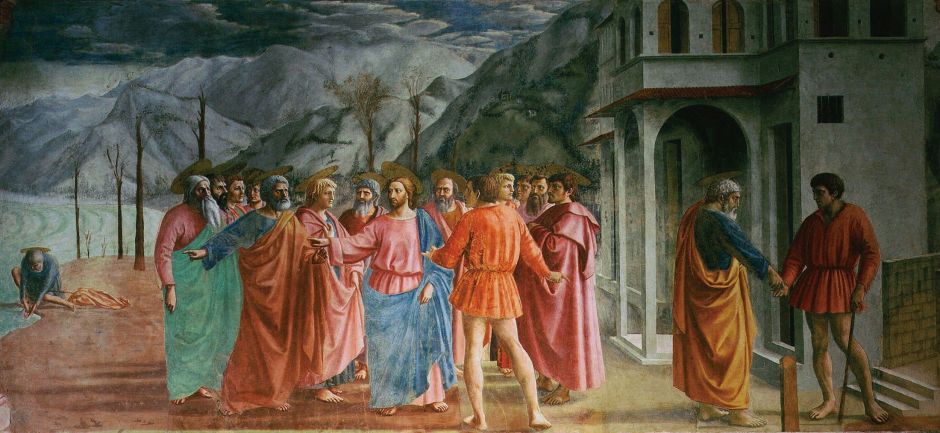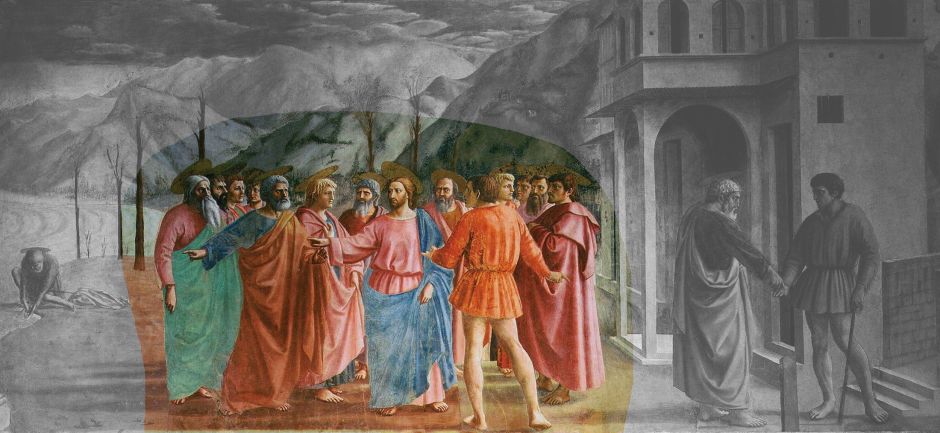Among the objectives in Renaissance painting were to make painted images more like real life, including the use of optically accurate perspective projection, and to tell visual stories better. Whilst there has been extensive coverage of the first of these, narrative in paintings has been largely overlooked. In this and tomorrow’s articles I’m going to consider two examples of how narrative painting developed during the Renaissance in southern Europe.
The first can be seen in one room: the frescoes in the Brancacci Chapel of the church of Santa Maria del Carmine, in the city of Florence, Italy. Sometimes known as the Sistine Chapel of the early Renaissance, its walls were painted by three of the great artists of the 1400s: Masaccio (1401–1428), Masolino (c 1383-1447), and Filippino Lippi (c 1459–1504), who was the illegitimate son of Fra Filippo (Lippo) Lippi (c 1406-1469).
Of the sixteen frescoes painted by these three, twelve remain in surprisingly good condition considering their age, and the fire which nearly destroyed them all in 1771. Most are relatively small and show single scenes, but there are four larger paintings which I will concentrate on, as they’re big enough to support proper storytelling.

The first thing apparent is that these four larger paintings are only visible after you have passed well into the chapel, and are each sufficiently high on the wall as to make you look up to see them. One potential problem with perspective projection from 3D to 2D, when it was discovered by Brunelleschi in the early years of the fifteenth century, was how accurately positioned the viewer needs to be to read the perspective in a painting. Near-contemporary accounts claim that Brunelleschi’s first demonstration relied on a peephole to ensure precise positioning, but that after further experiments he realised this wasn’t necessary.
This is worth bearing in mind here: despite careful attention to perspective projection in these frescoes, they are so high up that the viewer’s eye can never be where is should be placed in order to see them projected as they should be. Despite that, depth shown in the paintings remains thoroughly effective.

This diagram shows the four larger paintings which I consider here, relative to the others.

Taken as a whole, the paintings tell the story of the Christian ministry of Saint Peter, with a particular emphasis on healing and redemption for the poor. Although this was the chapel for a rich and powerful family, the church of Santa Maria del Carmine was situated in what was, at that time, a very poor area of Florence. The episodes in Saint Peter’s life which are included appear to offer hope for those poor, that a good Christian life would be met with rewards for the spirit, if not in the material existence.

The Crucifixion of Saint Peter and the Dispute with Simon Magus was one of the last of these to be painted, by Filippino Lippi in the early 1480s. It shows the final two episodes from the story of the life of Saint Peter: to the right we see him, with another saint, perhaps Paul, in his dispute with Simon Magus in front of the Emperor; to the left, his crucifixion.
Simon the Sorcerer, the Magician, or Magus, was a Samaritan who converted to Christianity, was baptised by Philip the Evangelist, and later came into conflict with Saint Peter, as recorded in Acts 8:9–24. Following the baptism of other newly-converted Christians, Saints Peter and John went to ensure that they also received the Holy Ghost. To accomplish this, Peter and John laid hands on the Christians.
Simon Magus saw this, and offered Peter and John money in return for being given the power to do the same. Peter rebuked him, for thinking that a gift of God could be bought, and called on him to repent. The influence of apocryphal literature, particularly the Golden Legend, extended this to bring Simon Magus and Saint Peter in front of the Emperor with their dispute.
Saint Peter’s martyrdom is not described in the New Testament, but was familiar to most at the time from apocryphal accounts, particularly in the Golden Legend and the Acts of Peter. Tradition held that this happened in the year of the Great Fire of Rome, 64 CE, and that Peter refused to be crucified in the same way that Christ had been, as he felt unworthy. He was therefore allegedly crucified in an inverted position, as depicted here. This was supposed to have taken place close to where he was buried, the location later chosen for the Basilica of Saint Peter in Rome.
Lippi shows these two events side-by-side within the same painting, with Saint Peter appearing before the Emperor at the right, and his legs being winched up on the inverted cross at the left. In the absence of any Biblical account, he has relatively free rein in what he shows, although the left background contains the very Florentine spire and towers of churches, and what may be the top of Brunelleschi’s great dome of the Santa Maria del Fiore cathedral in Florence.
Recalling my previous classification, Lippi here uses what is really multi-frame narrative, but by omitting the frame makes it look as if it’s multiplex.

The two events depicted in this fresco are recounted in the Acts of the Apostles, although they were separated in both time and place: the healing of the cripple took place in Jerusalem (Acts 3:1-10), and the raising of Tabitha in Joppa considerably later (Acts 9:36-43). Masolino, perhaps in conjunction with Masaccio, sets both events pictorially in the same town and apparently as consecutive events.
One day Saints Peter and John were going up to the Temple in Jerusalem together for afternoon prayer at about 1500. A man who had been lame from birth was there; each day he used to be carried to the Temple gate known as Beautiful, so that he could beg there. As Peter and John were passing, the lame man asked Peter for money. Peter replied that he had none to give him, and instead told him to walk. The lame man jumped to his feet, and walked into the Temple courts, jumping for joy and praising God for his healing.
In the town of Joppa, there was a disciple named Tabitha (or Dorcas), who was renowned for always doing good and helping the poor. She became sick and died; her body was washed and placed in an upstairs room. Saint Peter was sent for, and when he arrived, he was taken up to the room in which Tabitha’s body lay. Peter sent everyone out of that room, then prayed, and told her to get up. She opened her eyes, sat up, and was alive again.
The painting incorporates both stories at the same location, which is certainly not the Temple of Jerusalem. Saints Peter and John are shown with the cripple at the left, and Saint Peter again having raised Tabitha from the dead at the right. Between the two images of Saint Peter there are two Florentine figures who appear quite out of place.
Adjustments made to the depiction of the resurrection of Tabitha are substantial: she is shown in an open area at ground level, not upstairs. In the Biblical account, Saint Peter sent everyone else from the room before he worked the miracle, but here Tabitha is shown with three other figures in the ‘room’ area. However these allow the buildings to be integrated into a single coherent view, with one-point linear perspective. This is therefore true multiplex narrative, one step further than Lippi’s painting above.

This painting combines the narrative of the miracle performed by Saint Peter after he was released from prison, with some early church history which took place after that miracle. Peter was taken to the tomb of the son of Theophilus, the Prefect of Antioch. The son had been dead for fourteen years, but the saint raised him from the dead. The boy is shown here amid bones from the tomb, his hands raised in amazement.
Saint Peter is seen standing in front of the boy, and again in a painting hanging at the right. According to the story, this miracle so impressed the people of Antioch that they all converted to Christianity, and built a large church in the town. In the centre of that church they provided Saint Peter with a large chair, so that he could sit throughout the long sermons, as shown in the painting.
This is another multiplex narrative, but this time the later event (Saint Peter sitting in his chair) is set as a picture within the picture.
It’s Masaccio’s painting of The Tribute Money which is the most special here in terms of how its handles the narrative, and I think that it is also the finest of these brilliant paintings.

Masaccio’s fresco, believed to have been painted in 1425-28, contains three images of Saint Peter, and two of the tax gatherer, which are carefully set and coherently projected into the same single view. Although each is spaced apart from the next, no pictorial device is used to separate them into frames, and they are highly developed multiplex narrative.
His literary reference is to the Gospel of Matthew, in a story in which Christ directs Peter to find a coin in the mouth of a fish so that he can pay the temple tax. In the centre, the tax collector asks Christ for the temple tax. At the far left, as indicated by Christ and Peter’s arms, Peter (for the second time) takes the coin out of the mouth of a fish. At the right, Peter (a third time) pays the tax collector (shown a second time) his due.
Verbal narratives have the benefit of a medium which is read or heard over time, and has specific semantic markers of time – in language, tenses, for example. For an artist working in a visual medium on a 2D surface such as a painting, the only device which they can use is space, to express time using spatial composition.

Masaccio makes the entry point the dominant group in the middle foreground, with the figure of Christ at its centre. As Christ and Peter 1 show with their arms, the second scene in the story is the figure at the left edge of the image.

Peter 2 is seen here in the same clothing, a fairly common means of telling the viewer that he’s the same figure as Peter 1. Here there’s the subtle twist that, when taking the coin from the mouth of the fish, he has removed his golden cloak and laid it on the bank beside him.

Having looked at the centre and left, the viewer’s eye now looks at the opposite edge, where they see Peter 3 and Tax Collector 2, following their respective dress code, as the saint pays the tax using a coin which he has just retrieved from the fish.
This use of space to depict time comes into conflict with the Renaissance objective of realism, though. To ensure this story looks consistent, Masaccio has therefore set each of those three scenes in the same coherent landscape and perspective projection. What we read as three separate scenes now forms a whole image. That’s a very unusual combination of painting and narrative genius.
Tomorrow I’ll look at a more complex multi-stage narrative, the life of Christ, Passion and Crucifixion.
References
The Brancacci Chapel on Wikipedia.
The Golden Legend on Wikipedia.
Eckstein NA (2014) Painted Glories. The Brancacci Chapel in Renaissance Florence, Yale UP. ISBN 978 0 300 18766 3.
Spike JT (1995) Masaccio, (French translation) Liana Levi. ISBN 978 2 8674 6133 0. (Also original English version and other translations.)

